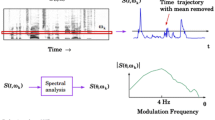Abstract
This paper presents new algorithms for acoustic echo cancellation and noise reduction which use two (or possibly more) microphone signals. In contrast to the single microphone method the multimicrophone approach can exploit the spatial coherence properties of sound fields which arise from noise and reverberated speech. Besides the standardfir echo canceller the proposed algorithms comprise an adaptive filter to eliminate non coherent signal components. The combined system achieves better Erle than thefir echo canceller alone, attenuates ambient noise, dereverberates near end speech, and possibly leads to implementations with reduced complexity. The paper analyzes the acoustical properties of typical environments, presents the algorithms and experimental results.
Résumé
Cet article présente de nouveaux algorithmes pour l’annulation d’écho et la réduction des bruits qui utilisent deux signaux (ou plus) provenant de microphones. Au contraire des méthodes utilisant un seul microphone, les approches à plusieurs microphones peuvent tirer parti des propriétés de cohérence spatiale des champs sonores qui sont générées par des bruits ou de la parole réverbérée. En plus de l’annuleur d’écho standard fir, les algorithmes proposés se caractérisent par la présence d’un filtre adaptatif dédié à l’élimination des composantes non cohérentes des signaux. Le système combiné permet d’obtenir un meilleur facteur Erle que l’annuleur d’écho fir seul. De plus, il atténue les bruits ambiants, déréverbère la parole proche et mène probablement à une réalisation dont la complexité serait réduite. L’article analyse les propriétés acoustiques d’environnements sonores typiques, présente les algorithmes et les résultats expérimentaux.
Similar content being viewed by others
References
Hänsler (E.). The hands-free telephone problem. An annotated bibliography.Signal Processing (1992),27, pp. 259–271.
Naylor (P.). Enhancement of hands-free telecommunications.Proc. Third Int. Workshop on Acoustic Echo Control, Lannion (Sep. 7–8, 1993).
Allen (J.), Berkley (D.), Blauert (J.). Multimicrophone signal-processing technique to remove room reverberation from speech signals.J. Acoust. Soc. Am. (Oct. 1977),62, n° 4.
Zelinski (R.). Noise reduction based on microphone array with lms adaptive post-filtering.Electronics Letters (Nov. 1990),26, n° 24, pp. 2036–2037.
Zelinski (R.). A microphone array with adaptive post-filtering for noise reduction in reverberant rooms.Proc. ICASSP,88, pp. 2578–2581.
Huhn (T.), Jentschel (H.-J.). Kombination von Geräuschreduktion und Echokompensation beim Freisprechen.Nachrichtentechnik, Elektronik (1993),43, n° 6, pp. 274–280.
Frost (O.). An algorithm for linearly constrained adaptive array processing.Proc. IEEE (Aug. 1972),60, n° 8, pp. 926–935.
Xu (M.), Grenier (Y.). Acoustic echo cancellation by adaptive antenna.1st Workshop on Acoustic Echo Control, Berlin (1989).
Widrow (B.), Glover (J.), McCool (J.), Kaunitz (J.), Williams (C), Hearn (R.), Zeidler (J.), Dong (E.), Goodlin (R.). Adaptive noise cancelling: principles and applications.Proc. IEEE (Dec. 1975),63, n° 12, pp. 1692–1716.
YasUkawa (H.). Acoustic echo canceller with subband noise cancelling.Electronics Letters (July 1992),28, n° 15, pp. 1403–1404.
Transmission performance of group audio terminals (gats).CCITT Recommendation P.30, Melbourne (1988).
Acker (Antweiler) (C), Vary (P.). Combined implementation of predictive speech coding and acoustic echo cancellation.Signal Processing, VI: Theories and applications, Vandewalle (J.)et al. (eds.), pp. 1641–1644,Eurasip, Elsevier (1992).
Schultheiss (U.). Über die Adaption eines Kompensators für akustische Echos.VDI Verlag (1988),10, n° 90.
Yamamoto (S.), Kitayama (S.). An adaptive echo canceller with variable step gain methods.Trans. IECE, Jap (1982),65, pp. 1–8.
Armbrüster (W.), Czarnach (R.), Vary (P.). Adaptive noise cancellation with reference input. Possible applications and theoretical limits.Signal Processing III: theories and applications. Young (I. T.),et al. (editors),Elsevier Science Publishers B.V., North Holland (1986), pp. 391–394.
Janse (K.), Kellermann (W.), Knibbeler (C), Martin (R.), Vary (P.). A noise reduction system for automobiles.Proc. Third Int. Workshop on Acoustic Echo Control, Lannion (Sep. 7-8, 1993).
Carter (G.). Coherence and time delay estimation.Proc. IEEE (Feb. 1987),75, n° 2, pp. 236–255.
Cowan (C), Grant (P.). Adaptive filters.Prentice Hall (1985).
Martin (R.), Vary (P.). A symmetric two microphone speech enhancement system. Theoretical limits and application in a car environnement.Processings of the fifth IEEE Signal Processing Workshop, Starved Rock State Park, Illinois (Sep. 13, 1992).
Author information
Authors and Affiliations
Rights and permissions
About this article
Cite this article
Martin, R., Vary, P. Combined acoustic echo cancellation, dereverberation and noise reduction: a two microphone approach. Ann. Télécommun. 49, 429–438 (1994). https://doi.org/10.1007/BF02999431
Received:
Issue Date:
DOI: https://doi.org/10.1007/BF02999431
Key words
- Telephone
- Echo
- Acoustic signal
- Echo canceller
- Acoustic noise
- Ambient noise
- Noise reduction
- Spatial coherence
- Diffuse reflection




